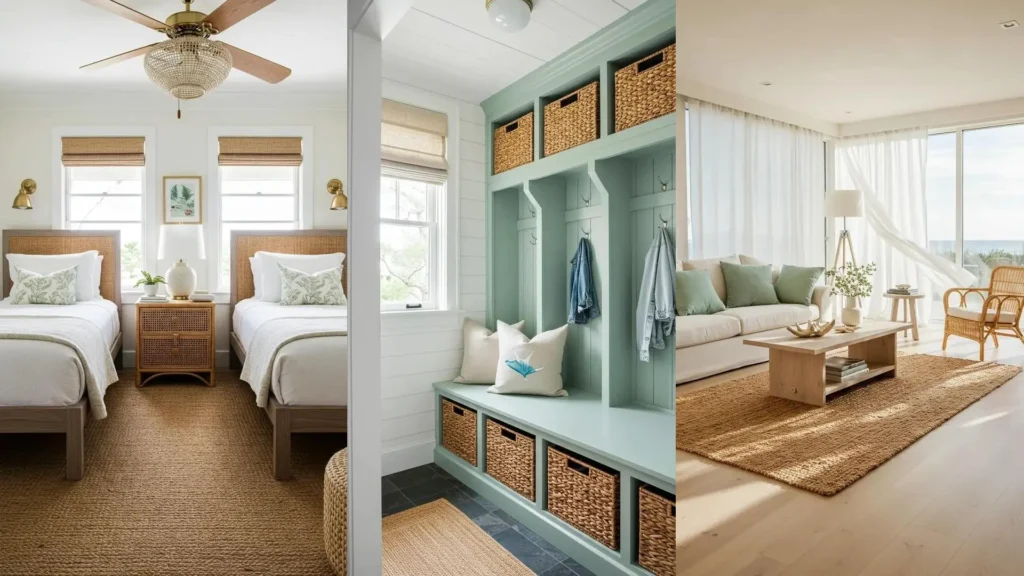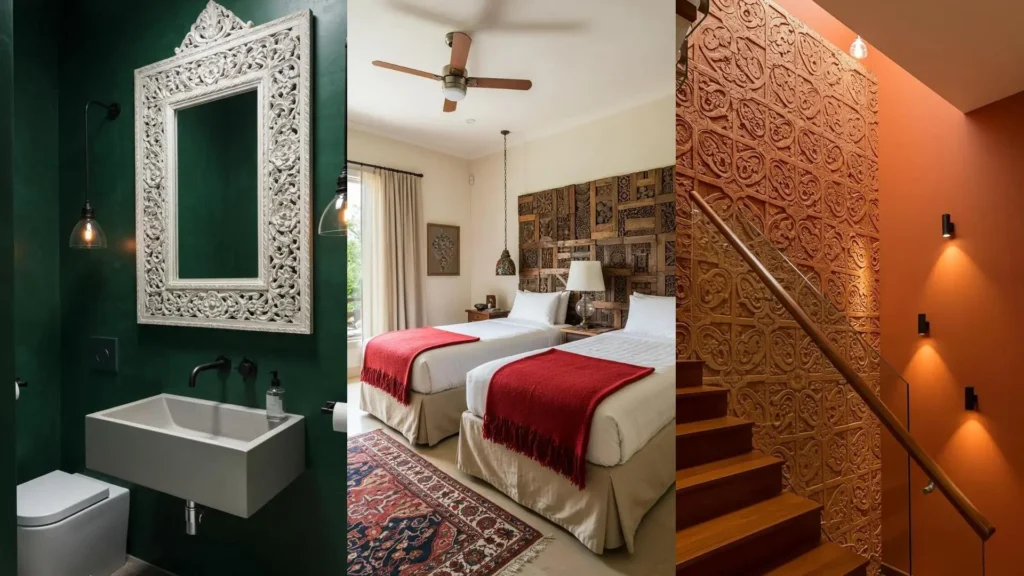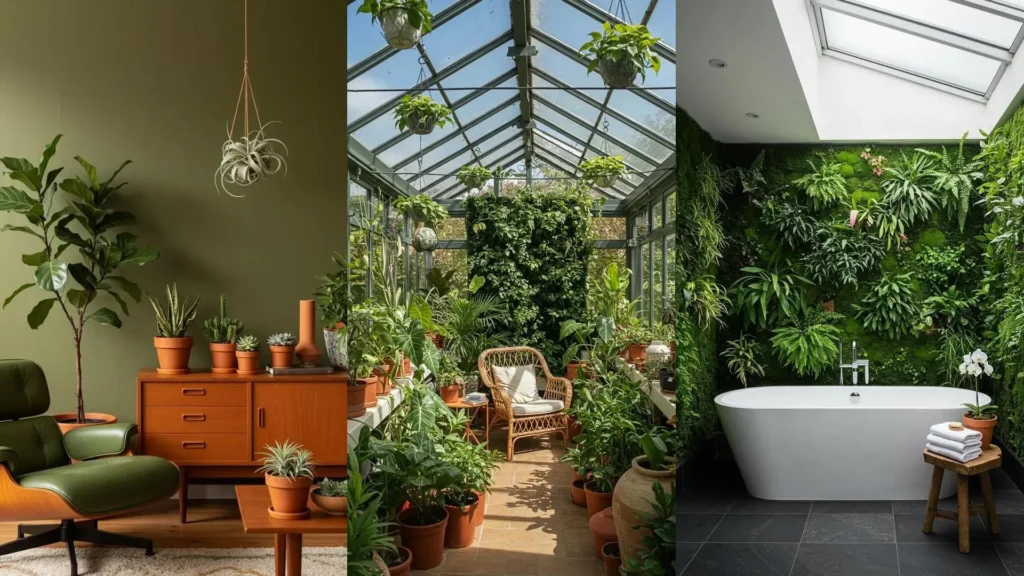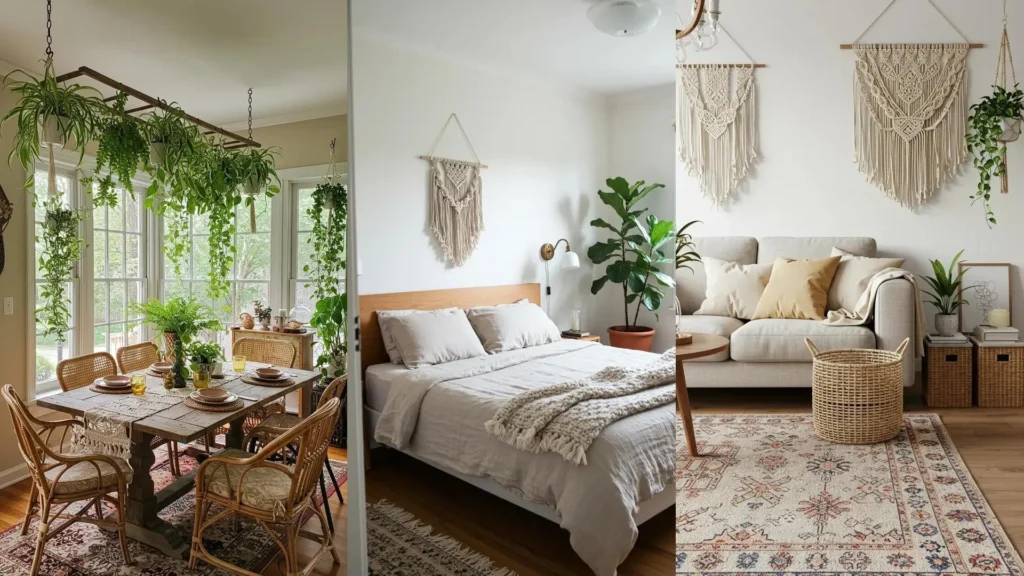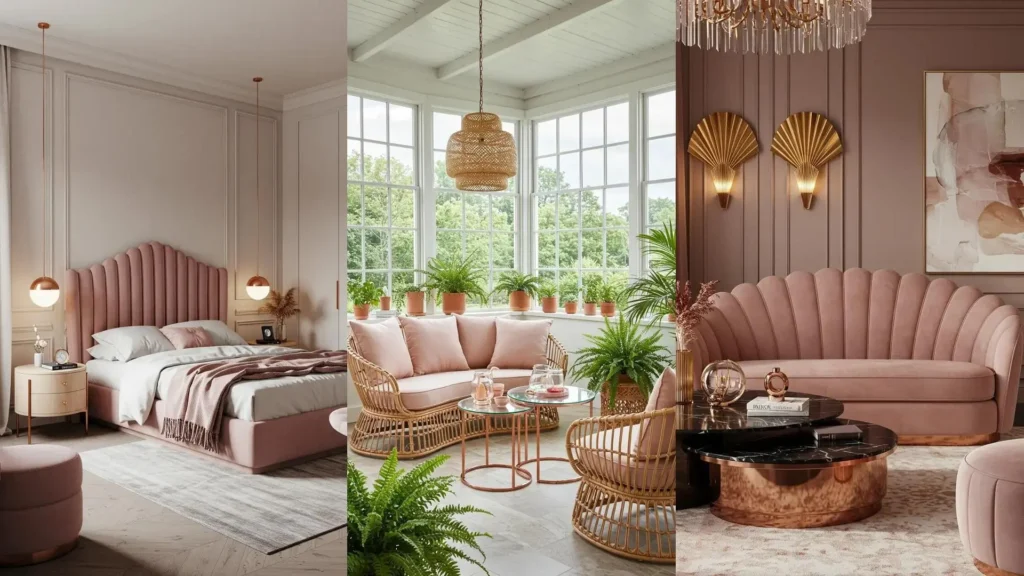There’s a quiet confidence to a neoclassical room, isn’t there?
It’s a style built on principles of order, light, and architectural grace—qualities that create a profound sense of calm and permanence in a home.
But achieving that elegance doesn’t require a historic chateau. It’s about learning to see the balance in a space, the power of a neutral palette, and the impact of a single, well-chosen detail.
Consider this your guide to bringing that thoughtful, classical spirit into your own rooms, creating a home that feels both timeless and entirely yours.
1. The Art of Relaxed Grandeur
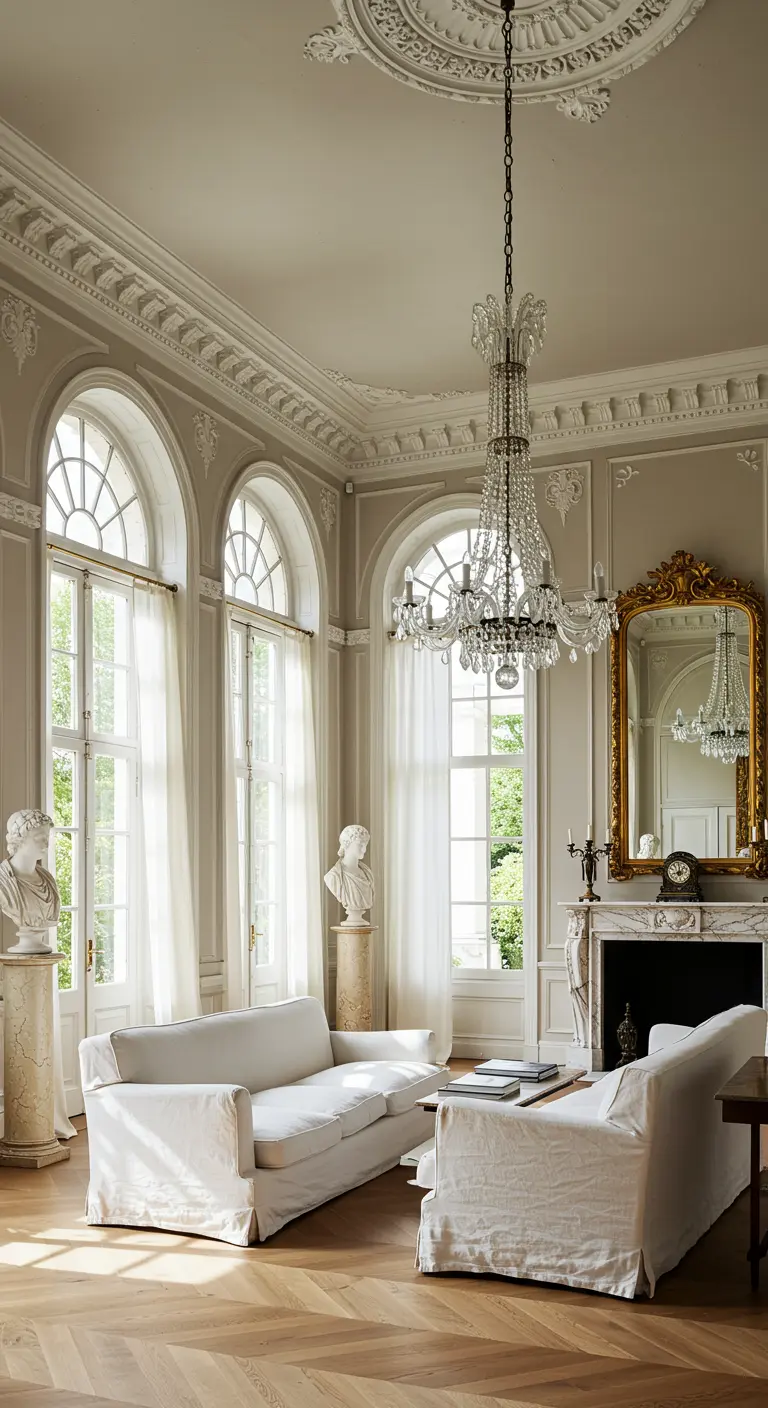
In a room with powerful architectural bones, soften the formality with relaxed, comfortable seating.
Here, crisp white slipcovered sofas provide a casual counterbalance to the ornate ceiling medallion, intricate moldings, and crystal chandelier.
This high-low mix makes the space feel inviting and livable, not like a museum.
For an even more accessible approach, try a simple linen or cotton slipcover over an existing sofa to instantly lighten the mood of a formal room.
2. Bridge Eras with Modern Lighting
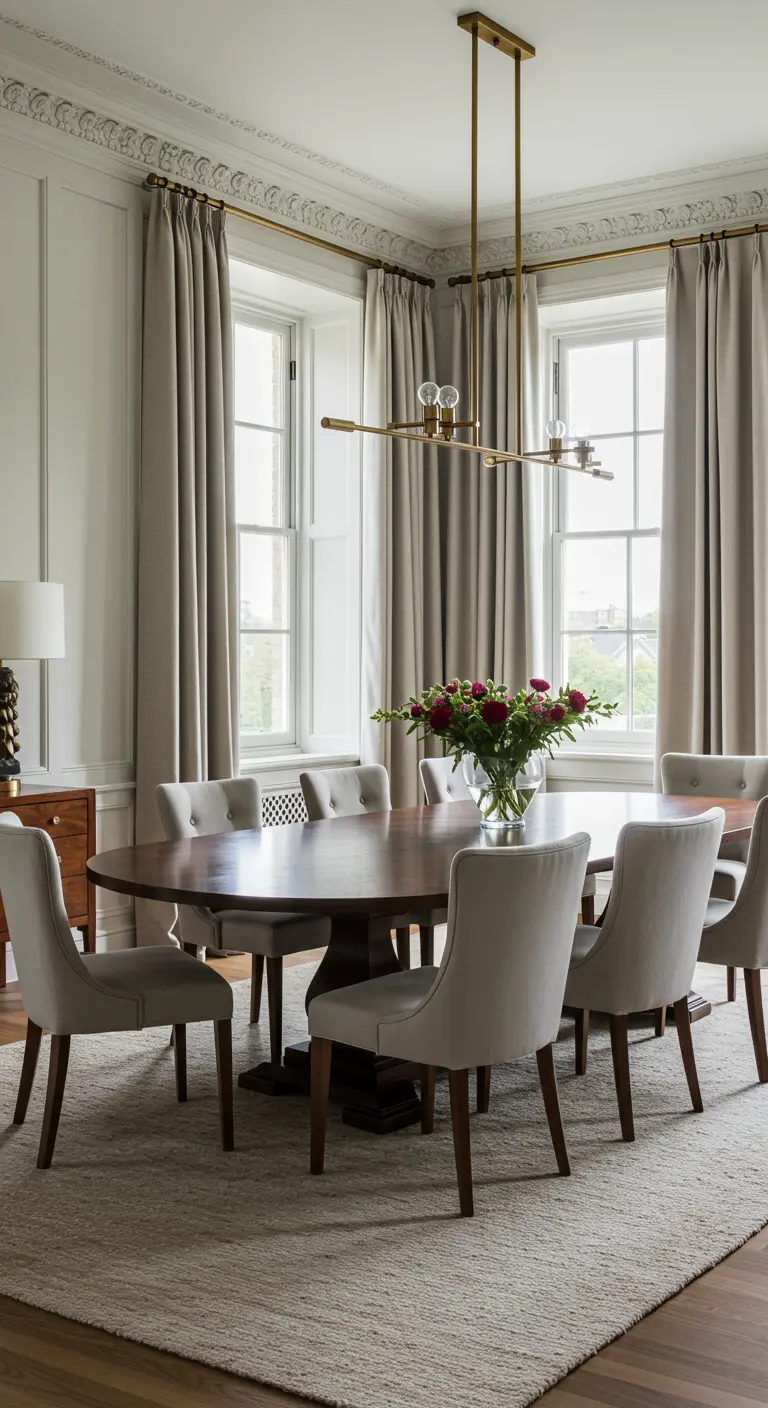
Update a traditional dining room by replacing a classic chandelier with a modern, sculptural light fixture.
Look for a piece with clean lines and a classic material, like the aged brass seen here, to bridge the gap between old and new.
This single swap prevents the room from feeling dated and adds an element of surprise.
Ensure the fixture is scaled correctly for your table—it should be about one-half to two-thirds the width of the table itself for proper balance.
3. Layer Tones for a Soothing Retreat
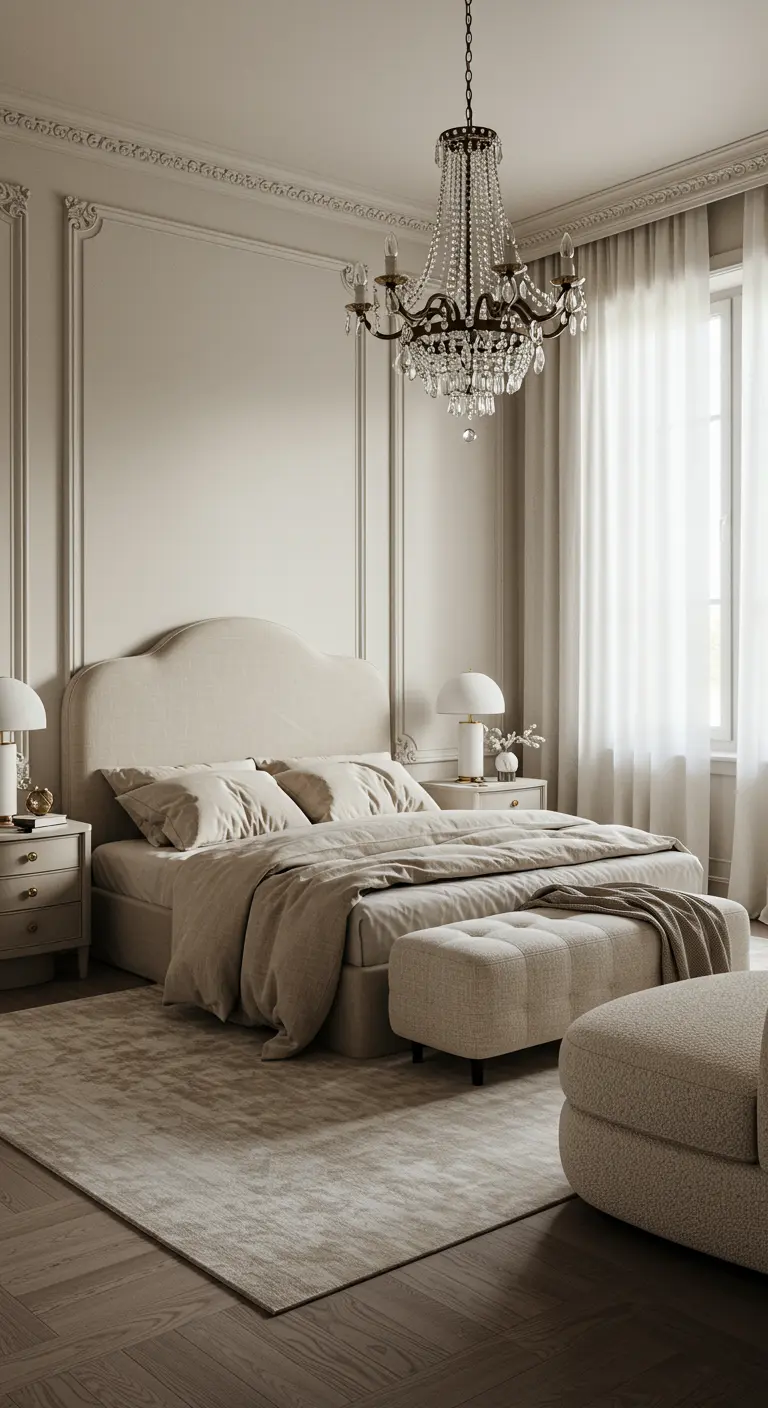
Create a deeply serene bedroom by layering various tones of a single neutral hue, like the greige and oatmeal palette here.
Combine different textures—soft linen bedding, a bouclé bench, a plush wool rug—to build depth and prevent the monochromatic scheme from feeling flat.
This approach, known as tone-on-tone decorating, is the secret to creating sophisticated and restful luxe bedrooms.
A crystal chandelier adds a touch of glamour without disrupting the calm.
4. Make a Statement with Geometric Flooring
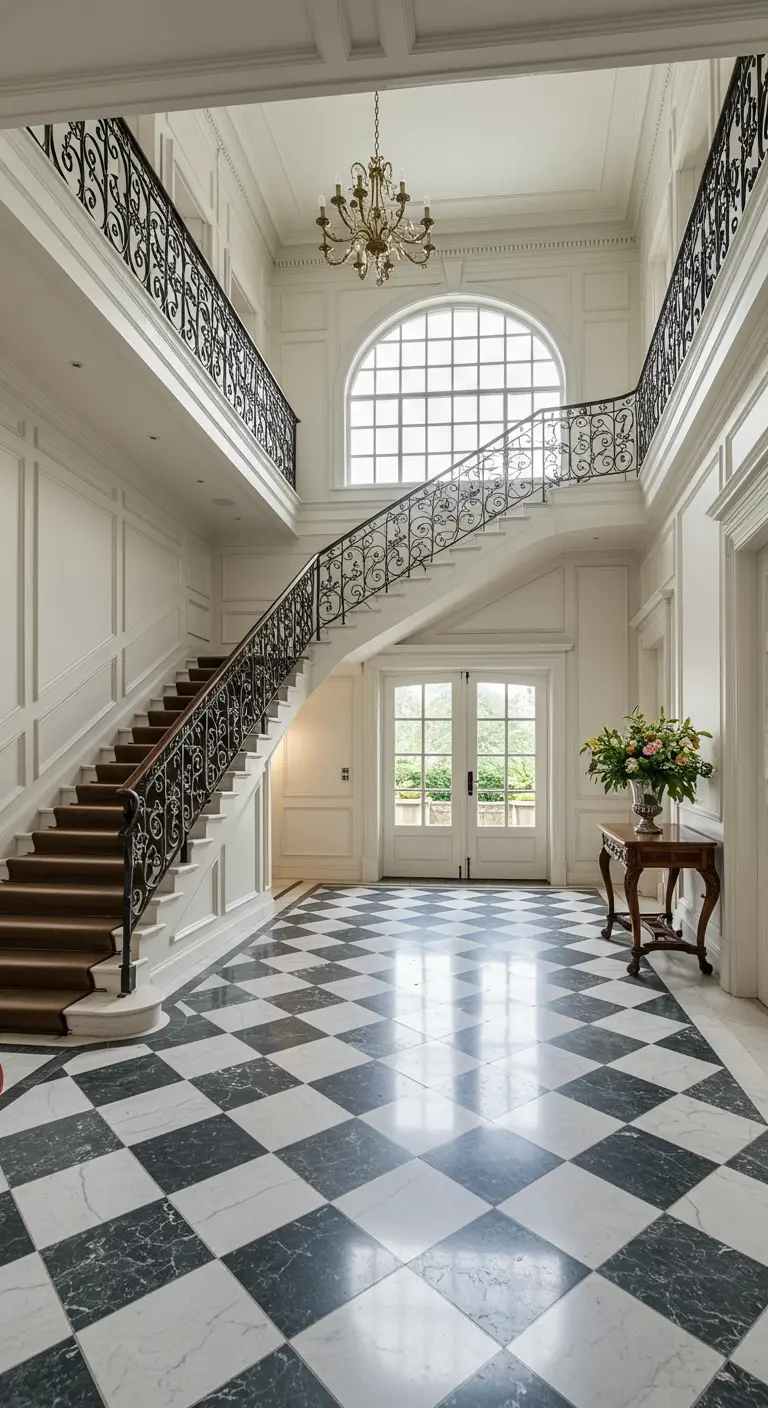
In a grand entryway, a bold, graphic floor provides a strong foundation and a timeless sense of style.
A classic black and white marble checkerboard pattern, like this one, immediately establishes a formal, elegant tone.
It anchors the vast, high-ceilinged space and complements the sweeping lines of the staircase.
For a more budget-friendly option, you can achieve a similar effect with large-format porcelain tiles or even painted floors in other black and white graphic spaces.
5. Embrace Mood with Saturated Color

While neoclassical design often leans on light neutrals, don’t be afraid to embrace deeper, more saturated colors.
In a study or library, painting the walls and built-in shelving in a single moody hue, like this charcoal gray, creates a cozy, enveloping atmosphere conducive to focus.
Integrated lighting within the shelves highlights the books and prevents the dark color from feeling oppressive.
These kinds of moody interiors feel both dramatic and incredibly intimate.
6. Juxtapose Classic & Contemporary Art
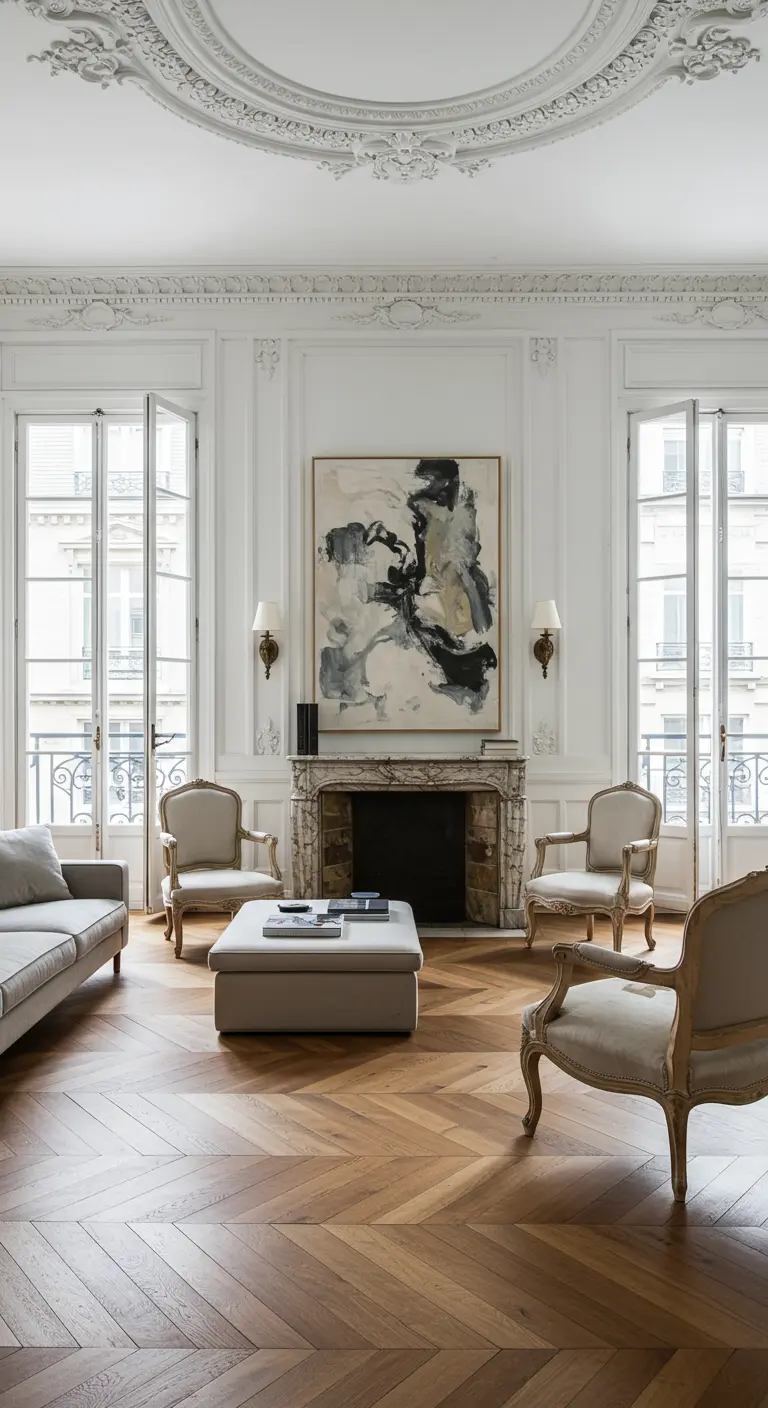
Breathe life into a traditional room by hanging a large-scale piece of contemporary abstract art.
The contrast between the ornate, historic architecture—like this marble fireplace and wall paneling—and the modern art creates a dynamic tension that feels fresh and personal.
This is a key strategy in creating transitional classic modern living spaces that honor the past while feeling firmly in the present.
Choose a piece with colors that subtly echo the tones in the room for a cohesive look.
7. Center the Room with a Sculptural Tub

In a bathroom with enough space, treat the bathtub as a piece of sculpture.
A freestanding clawfoot tub, especially one with ornate feet, becomes the undisputed focal point of the room.
Position it under a window or in the center of the space to emphasize its beautiful shape and transform your daily routine into a ritual.
This is a hallmark of spa-like bathroom retreats that prioritize both beauty and function.
8. Ground Your Design in Perfect Symmetry
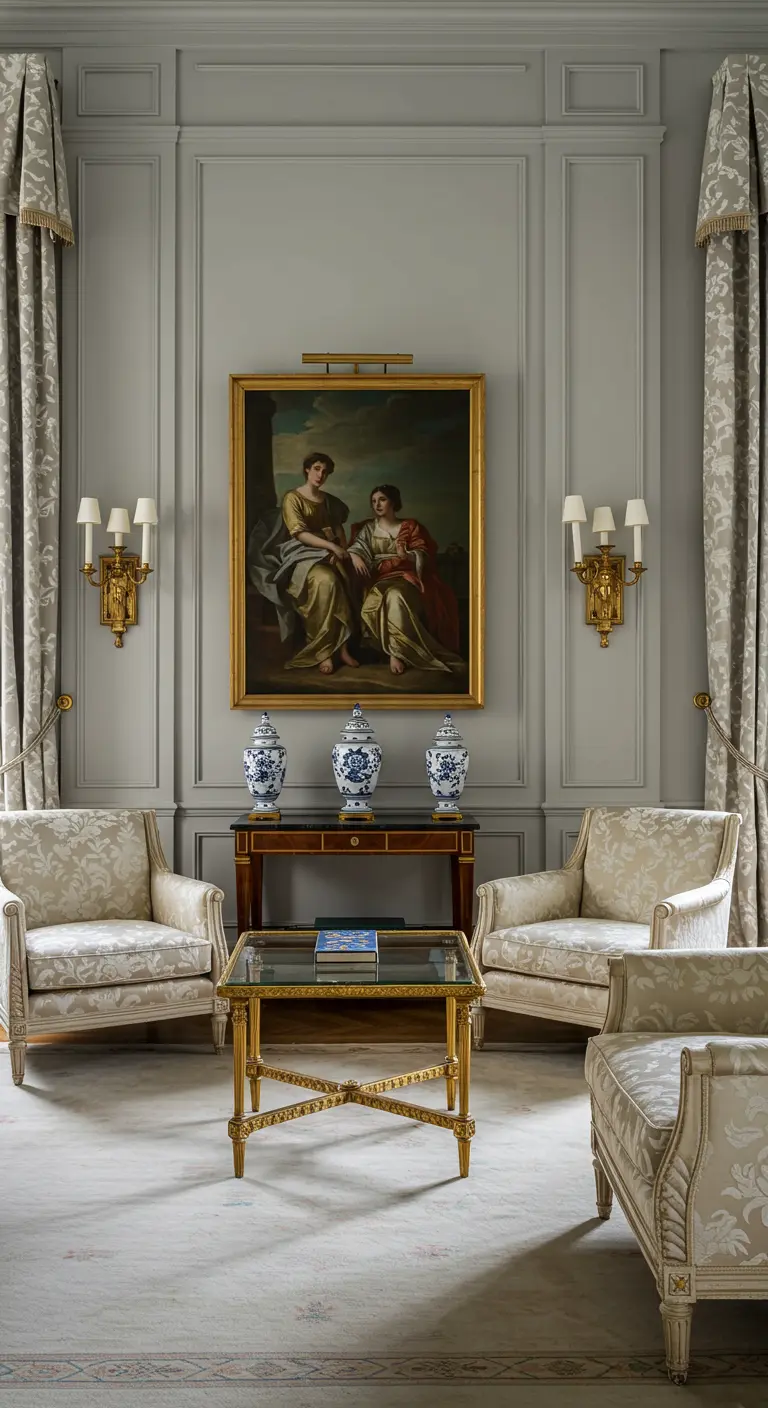
Symmetry is a foundational principle of classical design, and it’s one of the easiest ways to create a sense of order and calm.
Notice how the matching armchairs, sconces, and urns create a perfect mirror image on either side of the console table.
You can apply this in your own home by flanking a sofa with matching end tables and lamps, or placing identical chairs opposite each other.
This balanced approach is a calming principle often found in French country interiors and beyond.
9. Invite Nature In with Organic Textures
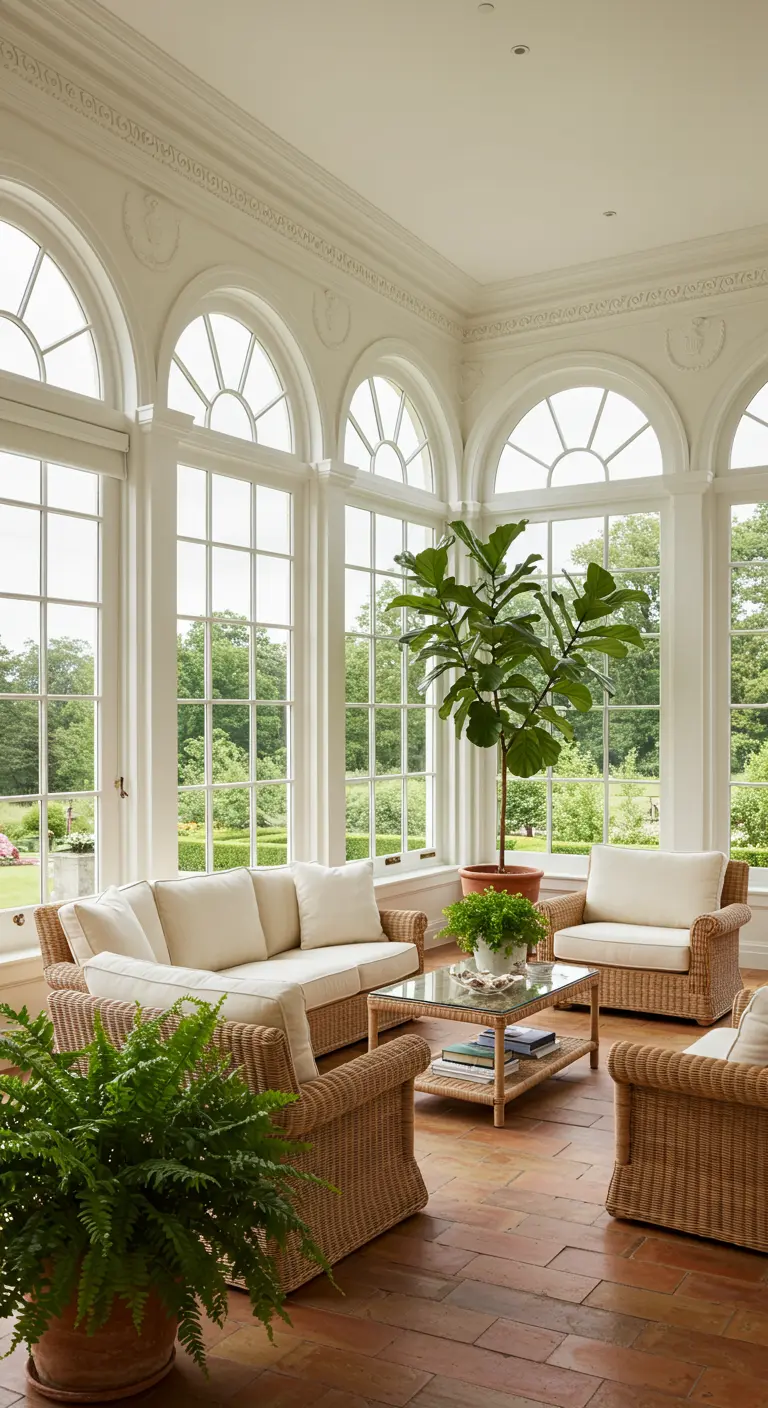
Balance the formality of neoclassical architecture by introducing natural, organic materials.
Wicker and rattan furniture bring warmth and a relaxed, earthy feel that connects the interior to the garden views outside.
These woven textures, along with plentiful indoor plants, prevent the grand room from feeling too stiff.
It’s a simple way to make a sunroom or living area feel like a seamless extension of the outdoors.
10. Create a Rhythmic Path with Repetition

In a long hallway or gallery, use repetition to create a powerful sense of rhythm and guide the eye forward.
The repeated sequence of classical statues, arched alcoves, and console tables here establishes a formal procession.
This turns a simple transitional space into a grand experience, reminiscent of a classic Tuscan villa interior.
At home, you can achieve a similar effect by hanging a series of identical framed prints along a corridor.
11. Lighten the Mood with Transparent Chairs
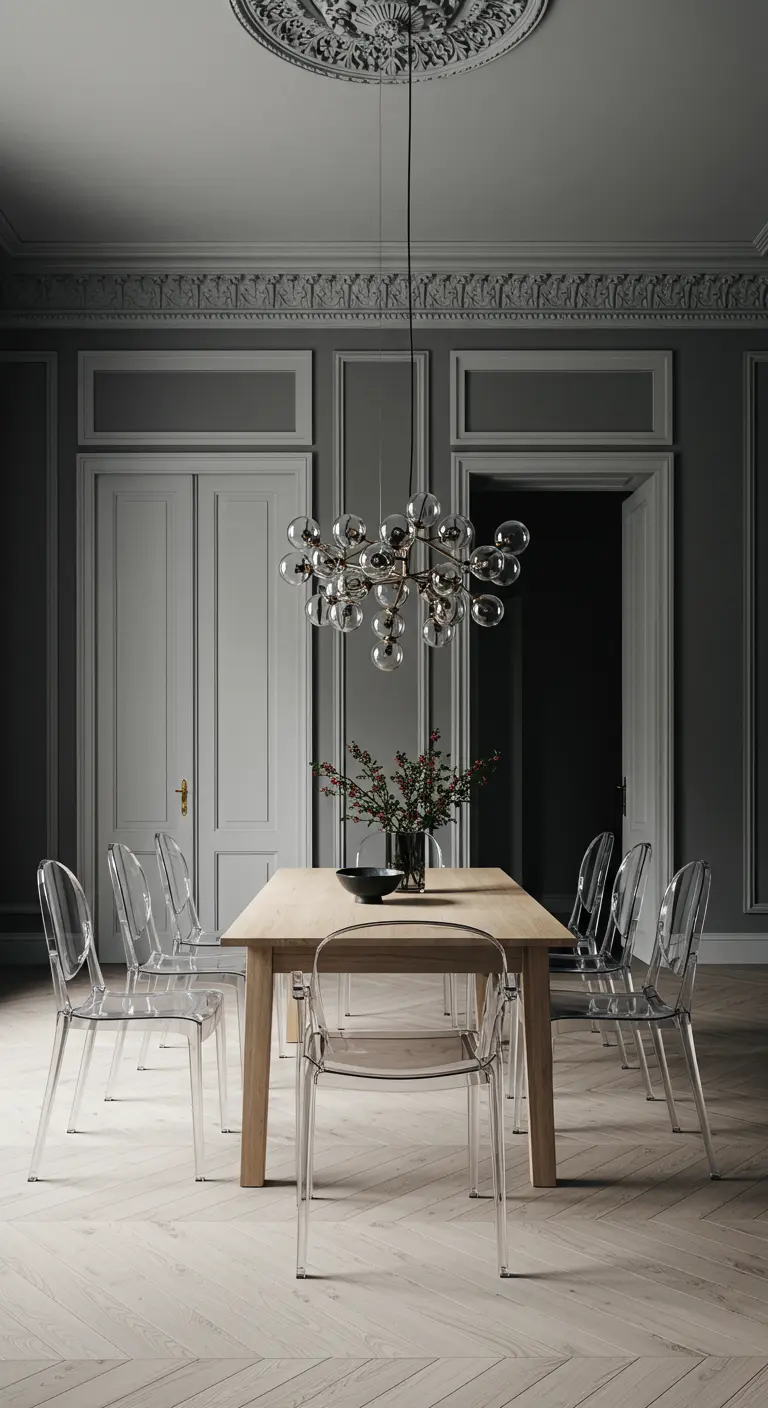
In a room with significant architectural details, like ornate moldings and paneled doors, choose furniture that doesn’t compete.
Modern acrylic or lucite chairs, often called “ghost chairs,” are a brilliant choice because their transparency allows the room’s features to remain visible.
They provide functional seating without adding visual bulk, a technique often used to make small spaces feel larger, but it works just as well here to preserve the integrity of the design.
12. Define a Nook with Architectural Lighting
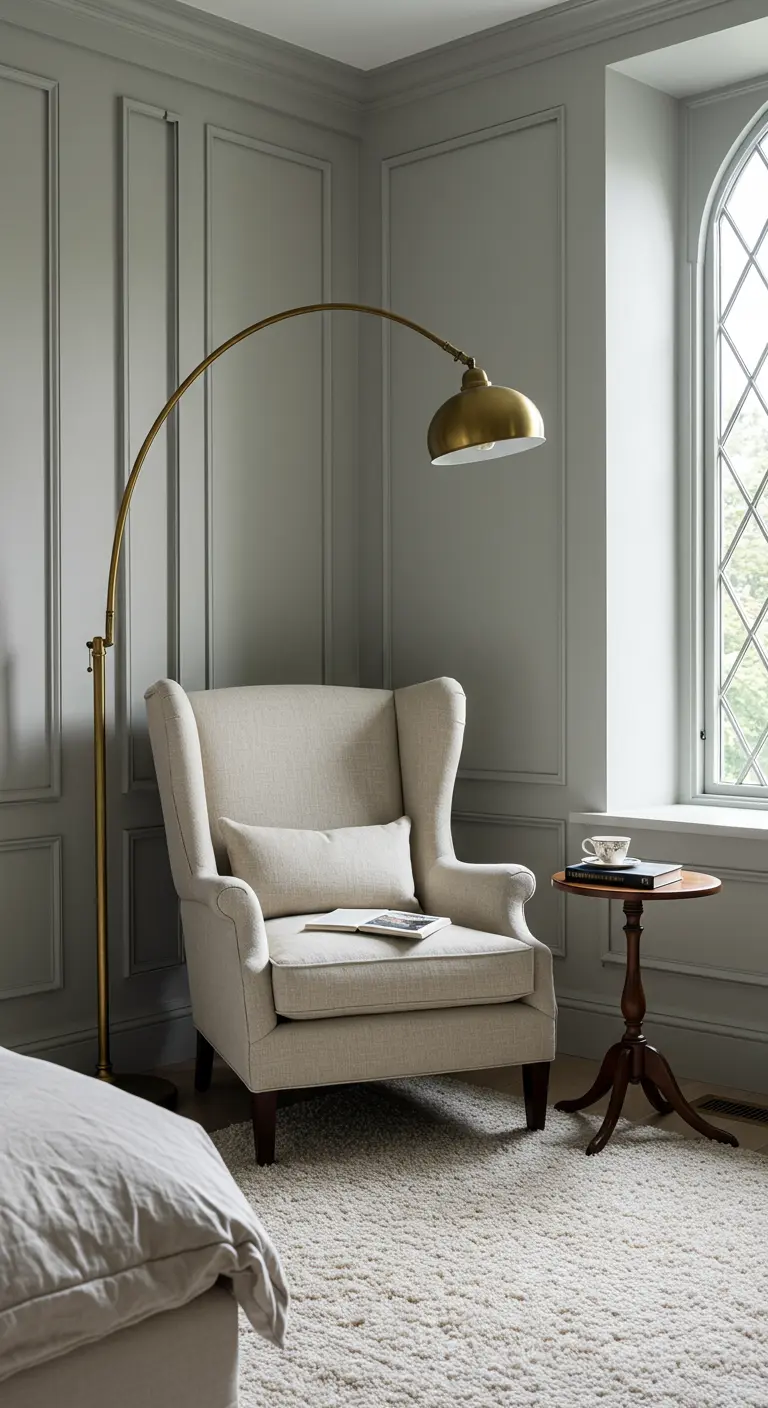
Carve out an intimate reading corner in a larger room using a statement floor lamp.
A large, arching lamp acts as a visual frame, creating a sense of enclosure and purpose for the space beneath it.
It defines the area without needing walls, making the wingback chair and side table feel like a deliberate, cozy corner designed for relaxation.
This is a particularly effective strategy for adding function to an underutilized corner.
13. Introduce Softness with Curved Shapes
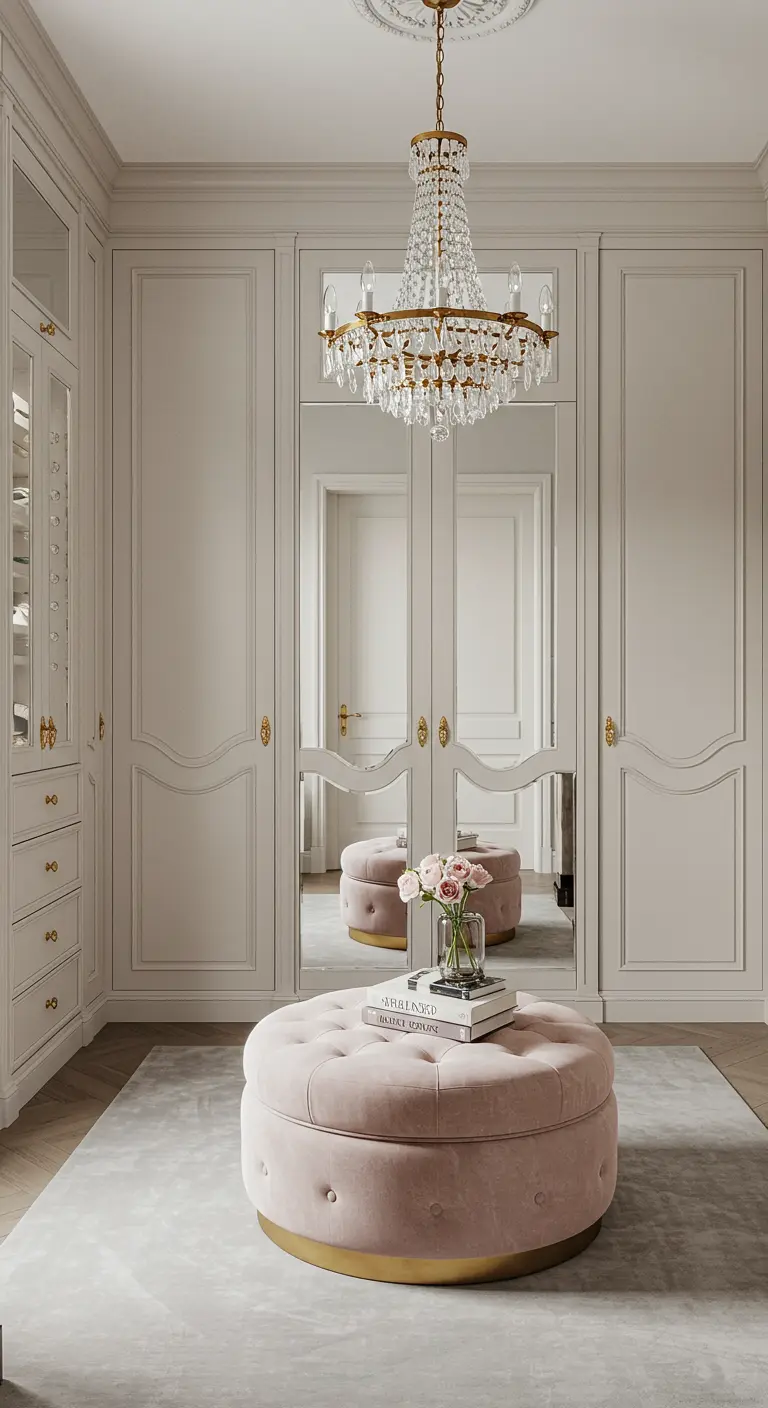
In a dressing room or bedroom dominated by the straight lines of wardrobes and walls, introduce a piece of furniture with soft curves.
A round, tufted ottoman immediately breaks up the grid-like structure, adding a graceful, feminine touch.
Choosing one in a gentle color, like this blush pink, brings in warmth and personality without overwhelming the serene palette.
The brass base adds a final touch of polished elegance.
14. Arrange Furniture for Living, Not Just Looking
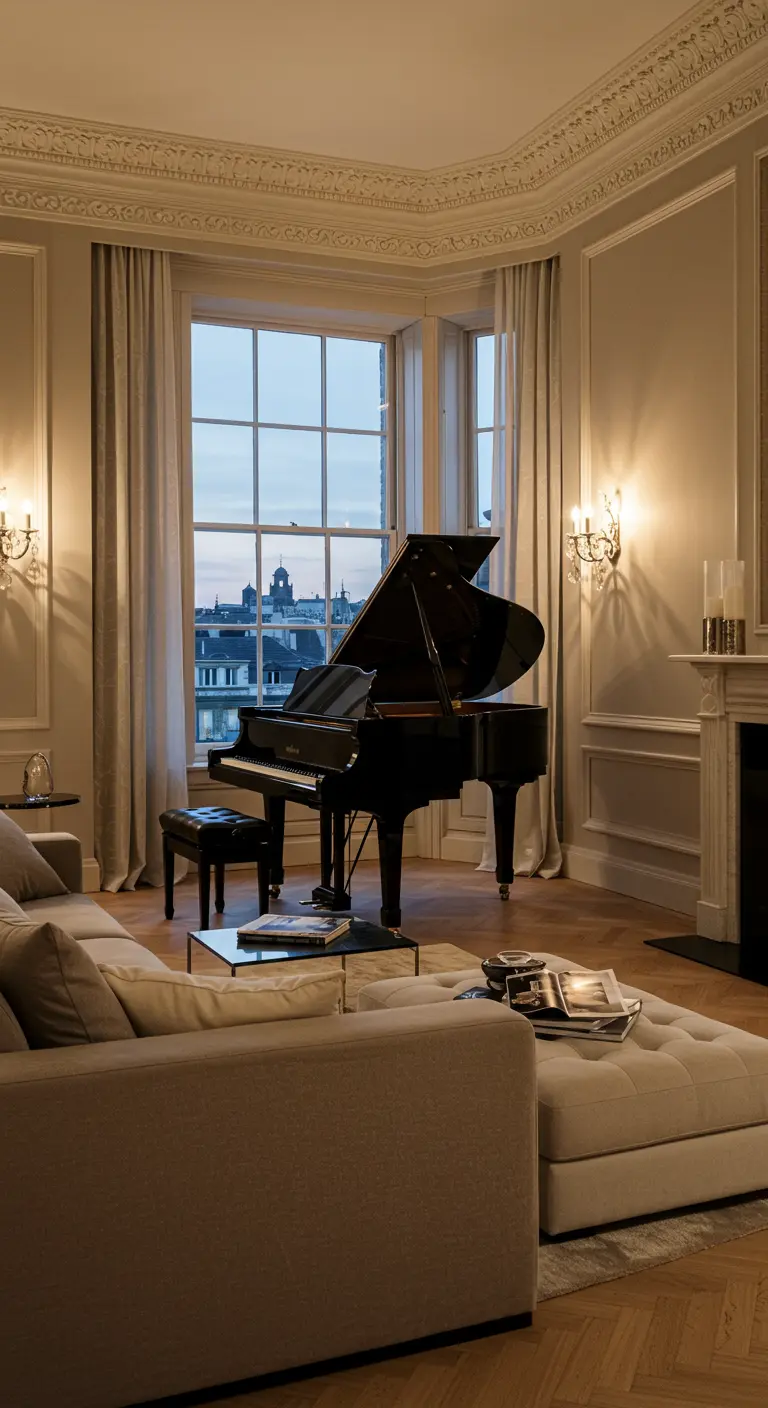
Even in a formal room, the furniture arrangement should support real life.
Here, the grand piano is a beautiful focal point by the window, but the sectional sofa is oriented inward to encourage conversation and relaxation.
Creating distinct functional zones—one for music, one for gathering—makes the room feel both elegant and useful.
A well-considered furniture layout is the key to a space that works as beautifully as it looks.
15. Let Texture Define a Monochromatic Room
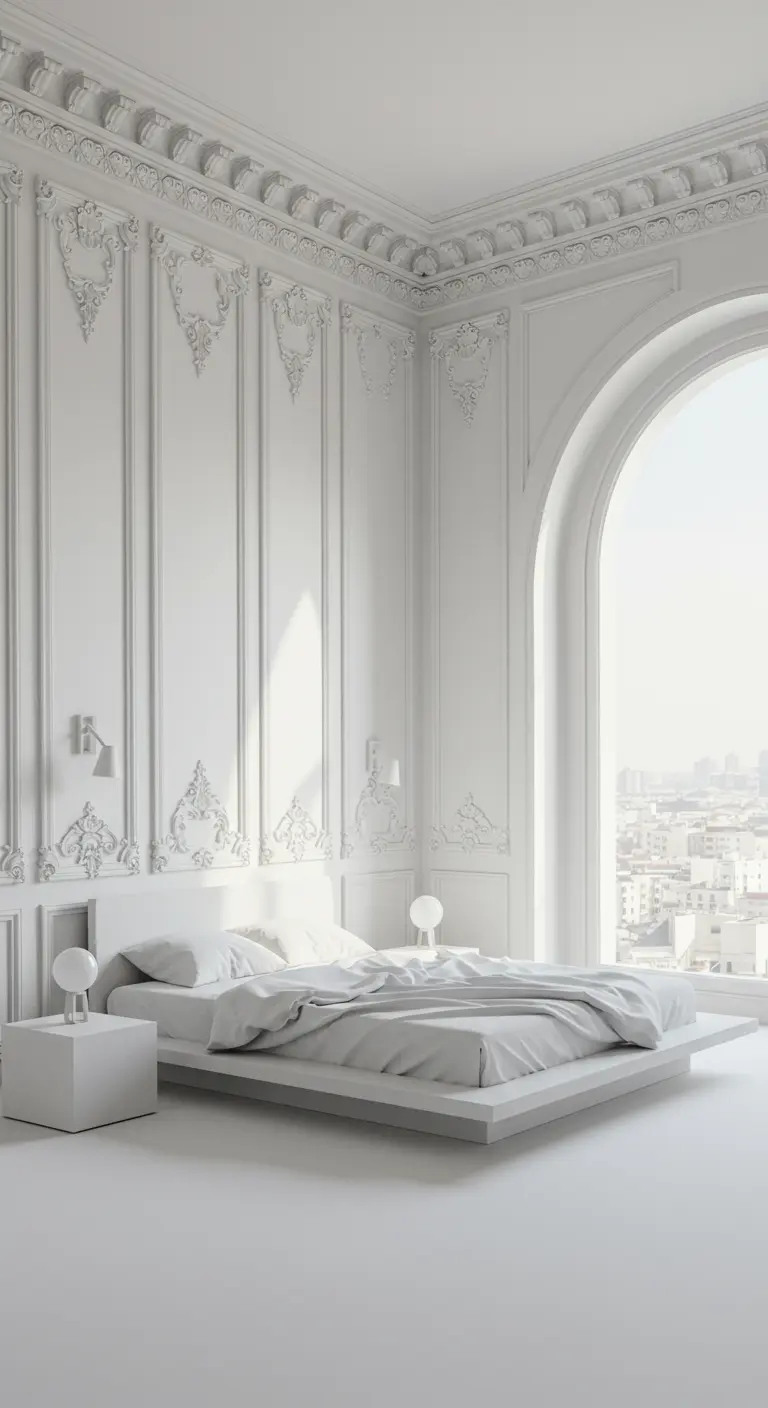
When you commit to a single color, texture becomes your most important tool for creating visual interest.
In this all-white bedroom, the depth comes from the contrast between different surfaces: the intricate, historical wall moldings, the crisp modern lines of the platform bed, and the soft, rumpled linen bedding.
An all-white palette is never boring when you layer textures with intention.
16. Unify an Open Plan with Cohesive Hardware
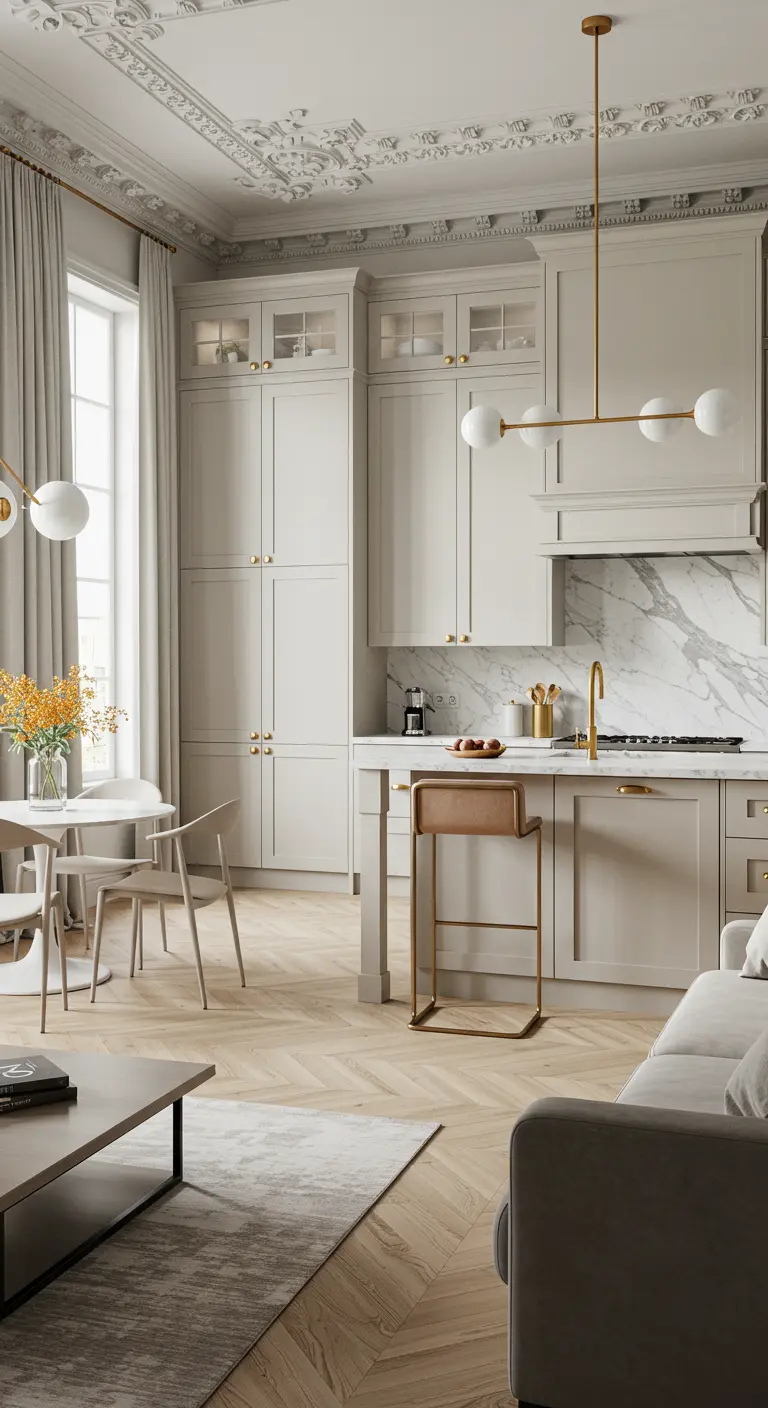
In an open-concept space, create a subtle but powerful sense of cohesion by using the same metallic finish throughout.
Here, the warm brass of the cabinet pulls, lighting fixtures, and bar stool legs ties the kitchen and living areas together seamlessly.
This repetition of brass hardware creates a polished, intentional look that makes the entire space feel harmonious.
It’s a small detail with a huge impact on the overall design.
17. Follow the Curve of Your Architecture
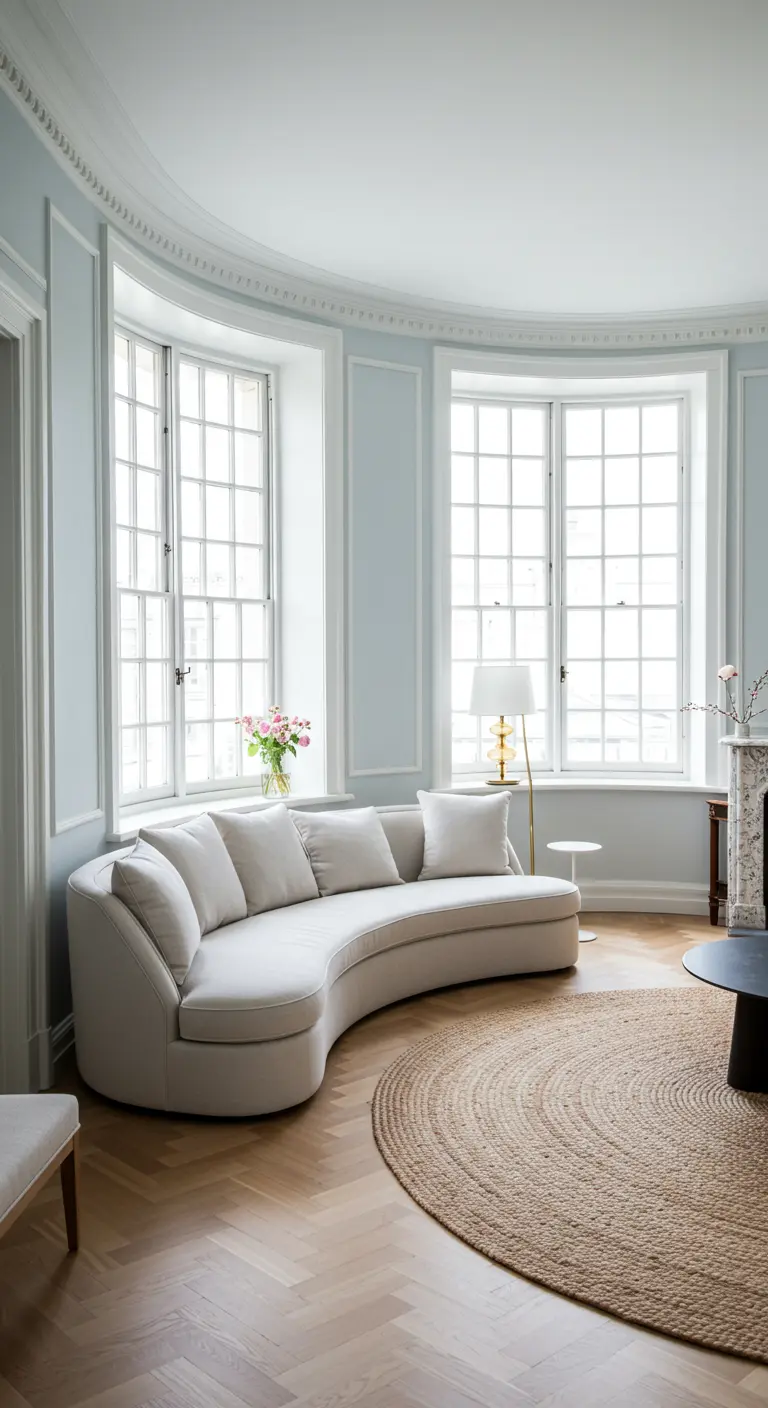
If your room has a unique architectural feature like a curved wall, embrace it with your furniture choices.
Placing a custom curved sofa along this bay of windows creates a beautifully harmonious and organic flow.
It makes the furniture feel as though it was designed specifically for the space, resulting in a cohesive and high-end look.
A round rug further accentuates the room’s graceful shape.
18. Amplify Light with a Leaning Floor Mirror
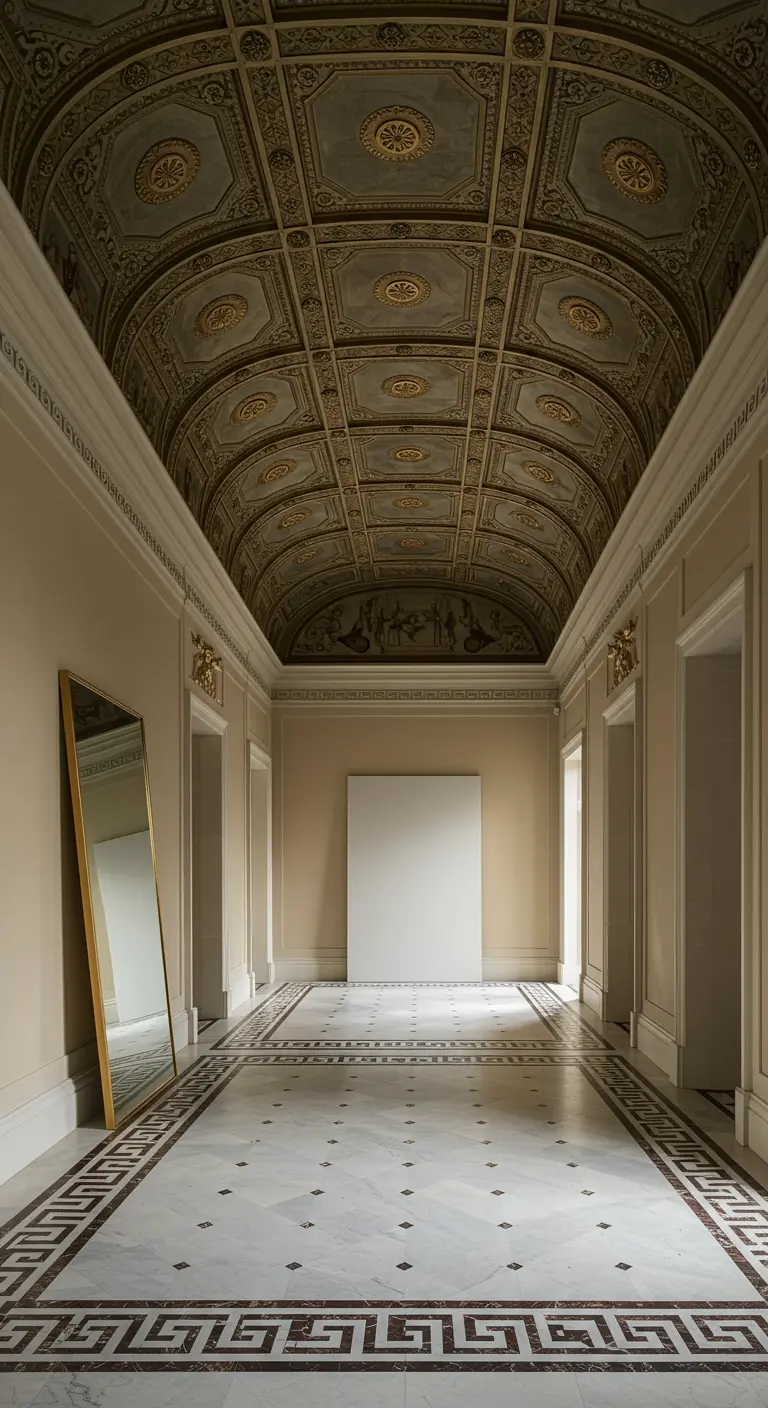
Use a large, leaning floor mirror as a strategic tool to transform a hallway or room.
It does more than just show your reflection; it bounces light into darker corners, creates the illusion of depth, and doubles the visual impact of beautiful features like this coffered ceiling and patterned floor.
By breaking up a long, solid wall, it adds an architectural element and prevents a corridor from feeling narrow.
19. Frame the Bed with Architecture
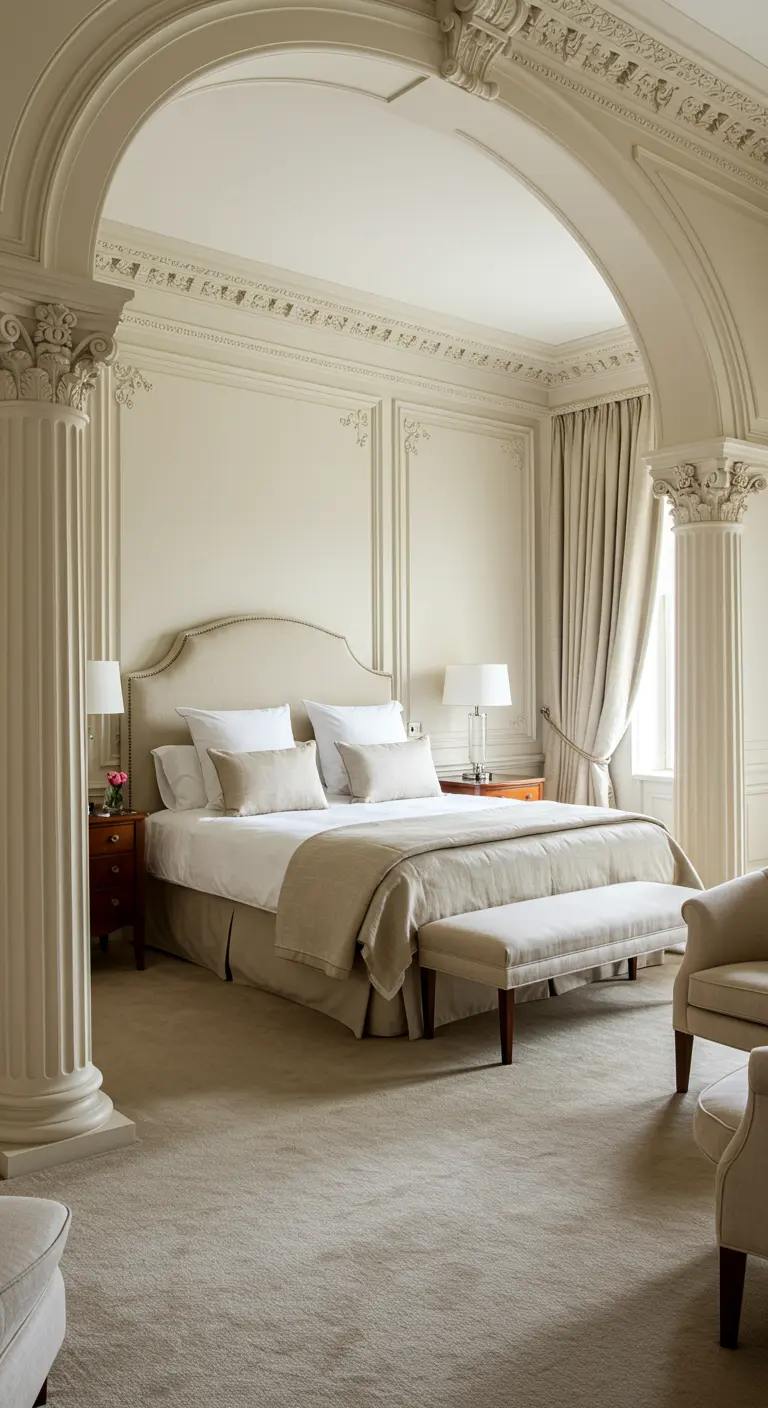
If your room possesses strong architectural elements, use them to your advantage.
Here, a grand archway supported by classical columns creates a natural and dramatic frame for the bed, serving as a built-in headboard of magnificent scale.
This design move elevates the bed to the undisputed focal point and gives the entire room a sense of purpose and grandeur.
It’s one of those dream bedroom inspirations that feels both timeless and majestic.
20. Create Drama Through Vertical Scale
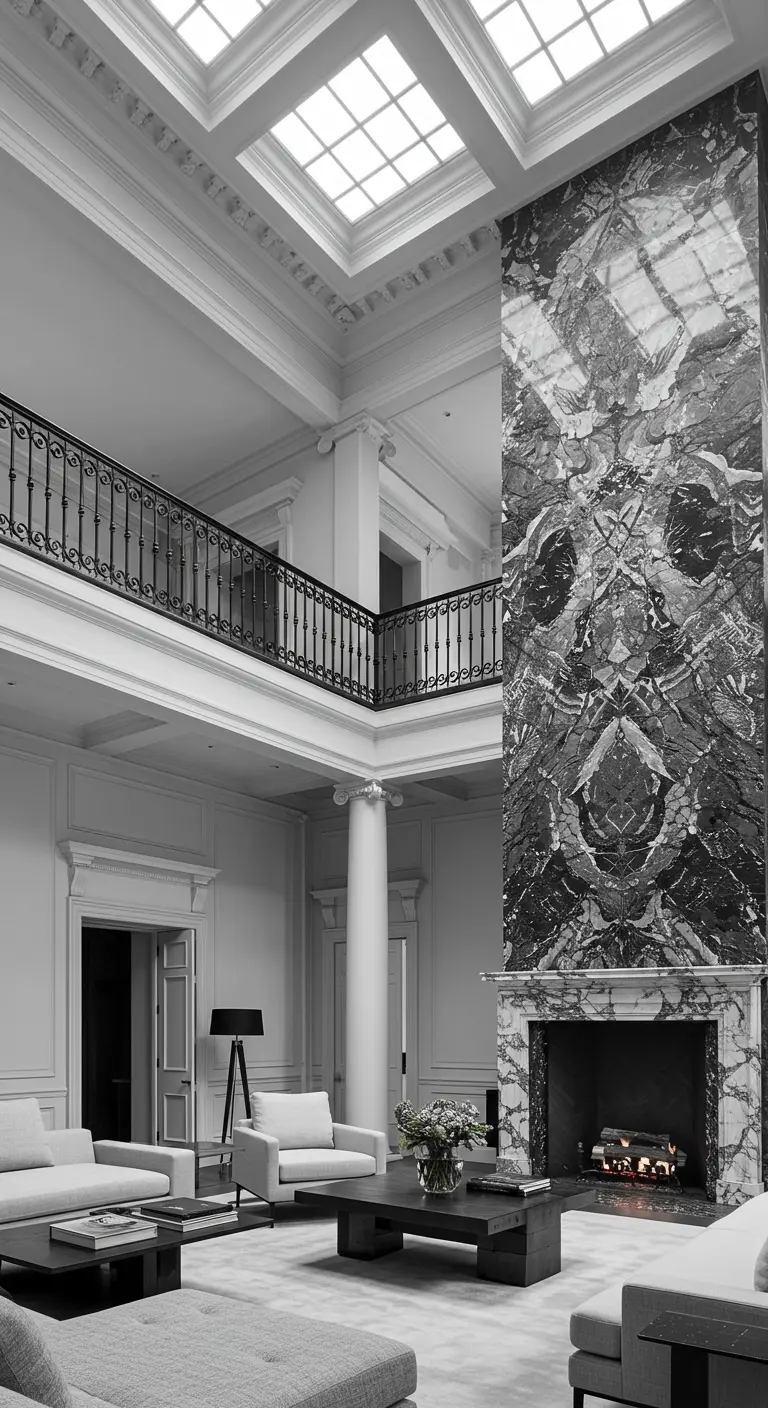
Draw the eye upward and create a breathtaking sense of drama by emphasizing vertical lines.
This incredible floor-to-ceiling marble fireplace commands attention and makes the room’s already high ceilings feel even more expansive.
The skylights above flood the marble with natural light, highlighting its beautiful veining and reinforcing the vertical orientation.
Even on a smaller scale, taking a feature wall or drapery to the ceiling has a similar, powerful effect.
21. Maximize Comfort with a Built-in Banquette
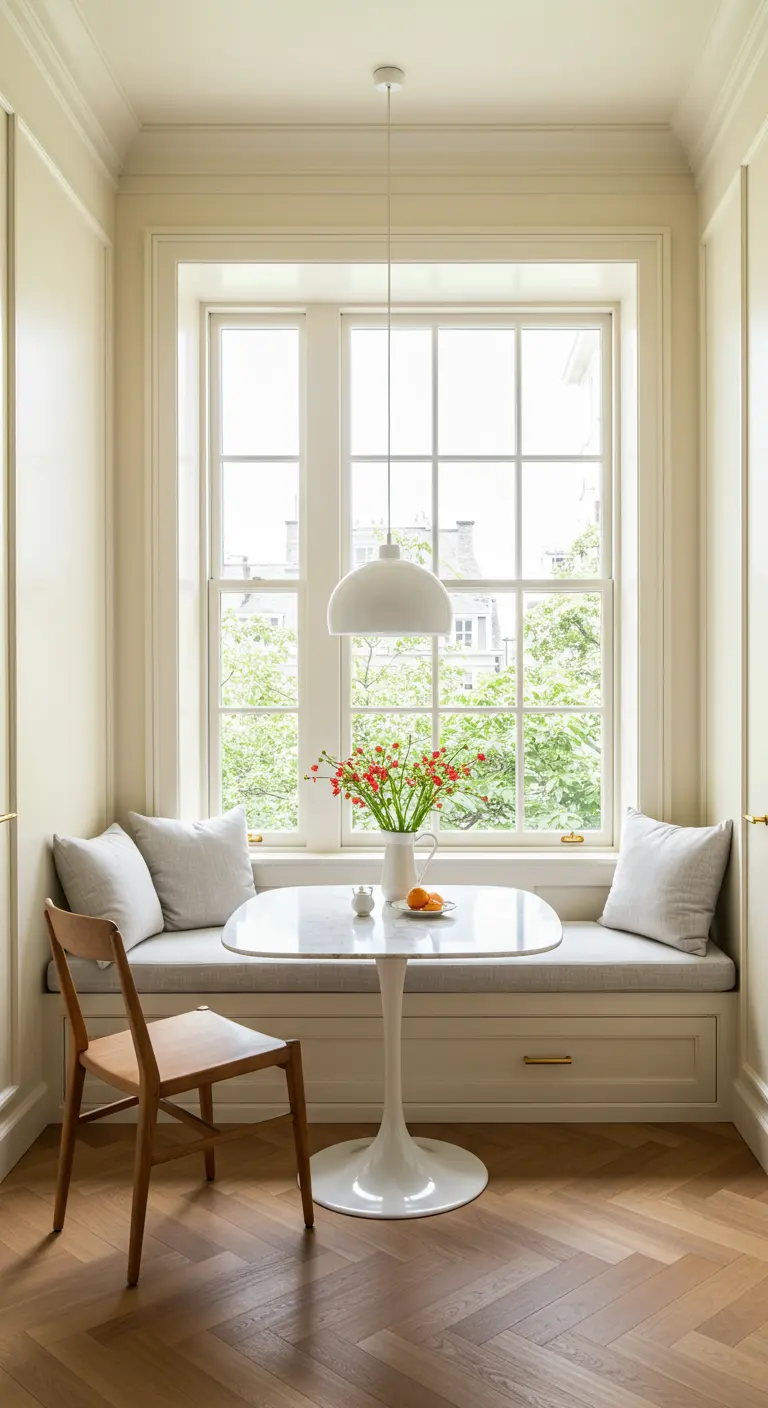
A built-in window seat or banquette is a wonderfully efficient and charming solution for a breakfast nook.
It provides generous, comfortable seating while taking up minimal floor space.
Incorporate drawers underneath for clever, hidden storage—perfect for stashing table linens or seasonal items.
Paired with a simple pedestal table and a single chair, it creates a cozy, cafe-like corner that feels both intentional and welcoming.
22. Curate a Timeless Gallery Wall
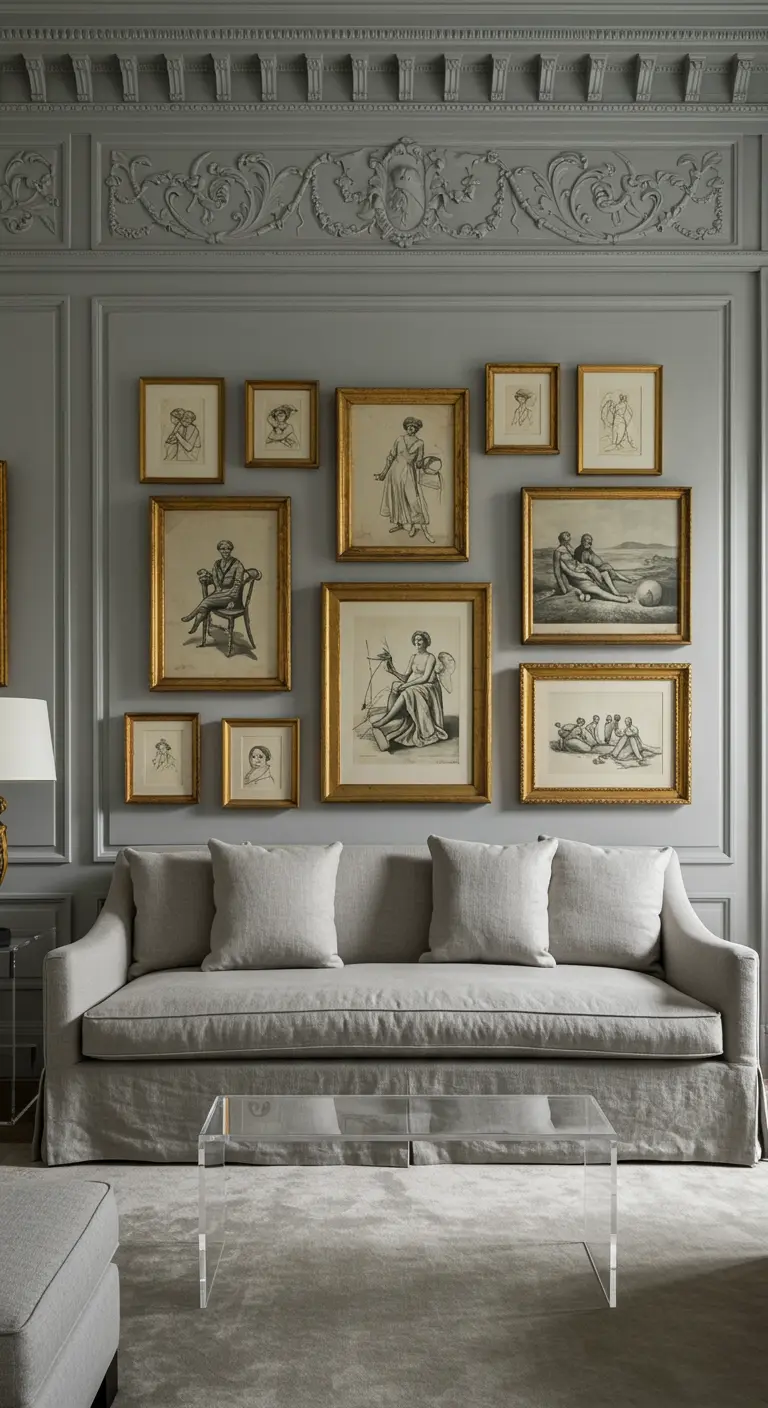
To create a sophisticated gallery wall, focus on cohesion through framing and theme.
Here, a collection of classical sketches and portraits is unified by simple, matching gold frames.
The salon-style hanging—a dense grouping of various sizes—transforms the collection into a single, impactful statement piece that anchors the sofa.
This approach adds a layer of personal history and intellectual curiosity to the room.
23. Go Bold in a Small Powder Room
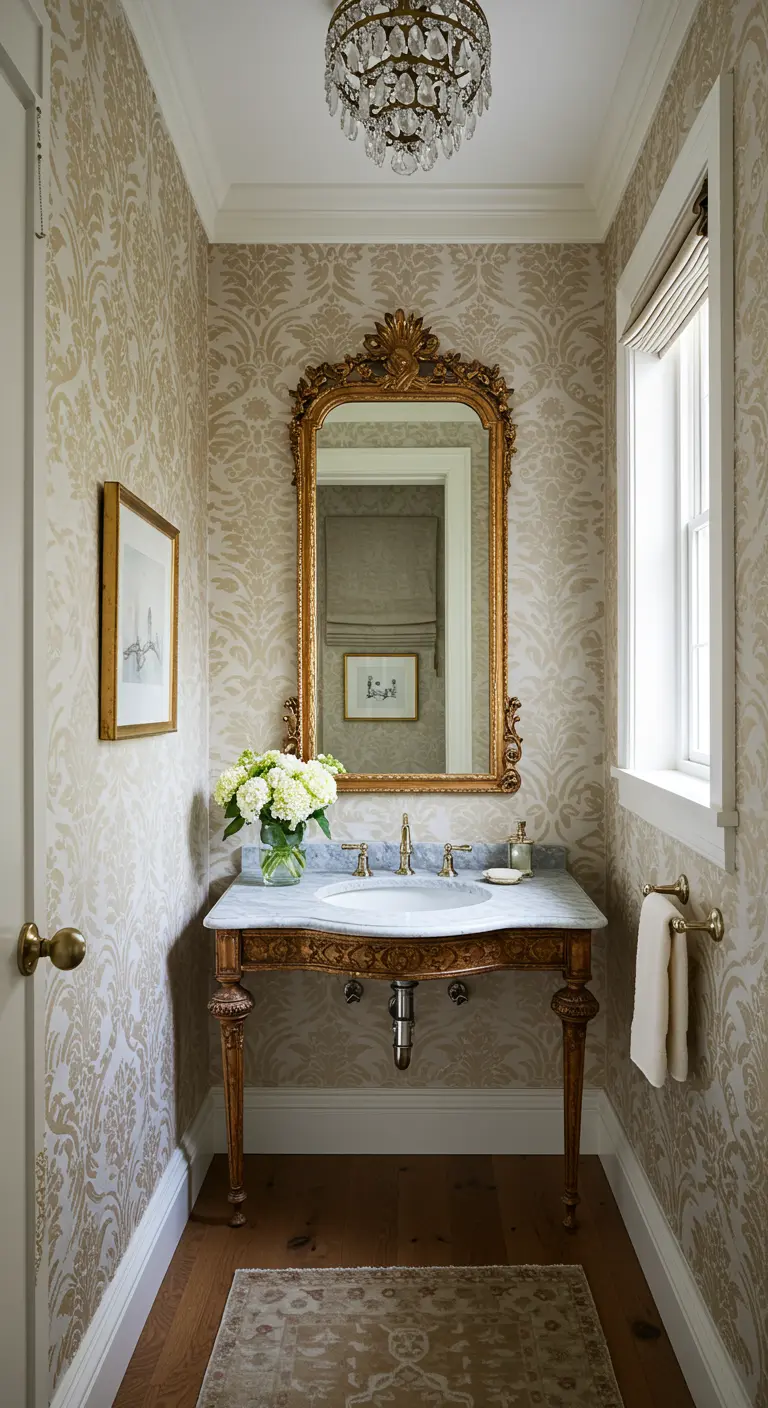
A powder room is the perfect space to experiment with bold design choices that might feel overwhelming in a larger room.
A dramatic, large-scale damask wallpaper envelops the space in pattern and texture, creating a jewel-box effect.
Pair it with an ornate, gilded mirror and a classic marble console sink to complete the look.
Don’t be afraid to go bold in your powder rooms; they are meant to surprise and delight.
24. Opt for a Soft, Versatile Centerpiece

Consider swapping a traditional wood or metal coffee table for a large, tufted ottoman.
It introduces a welcome softness into the living room, breaking up the hard lines of other furniture.
An upholstered ottoman also offers incredible versatility: use it as a footrest, for extra seating, or place a decorative tray on top to hold drinks and accessories.
It’s a practical and elegant choice for a family-friendly space.
25. Create Romance with Sheer Drapery
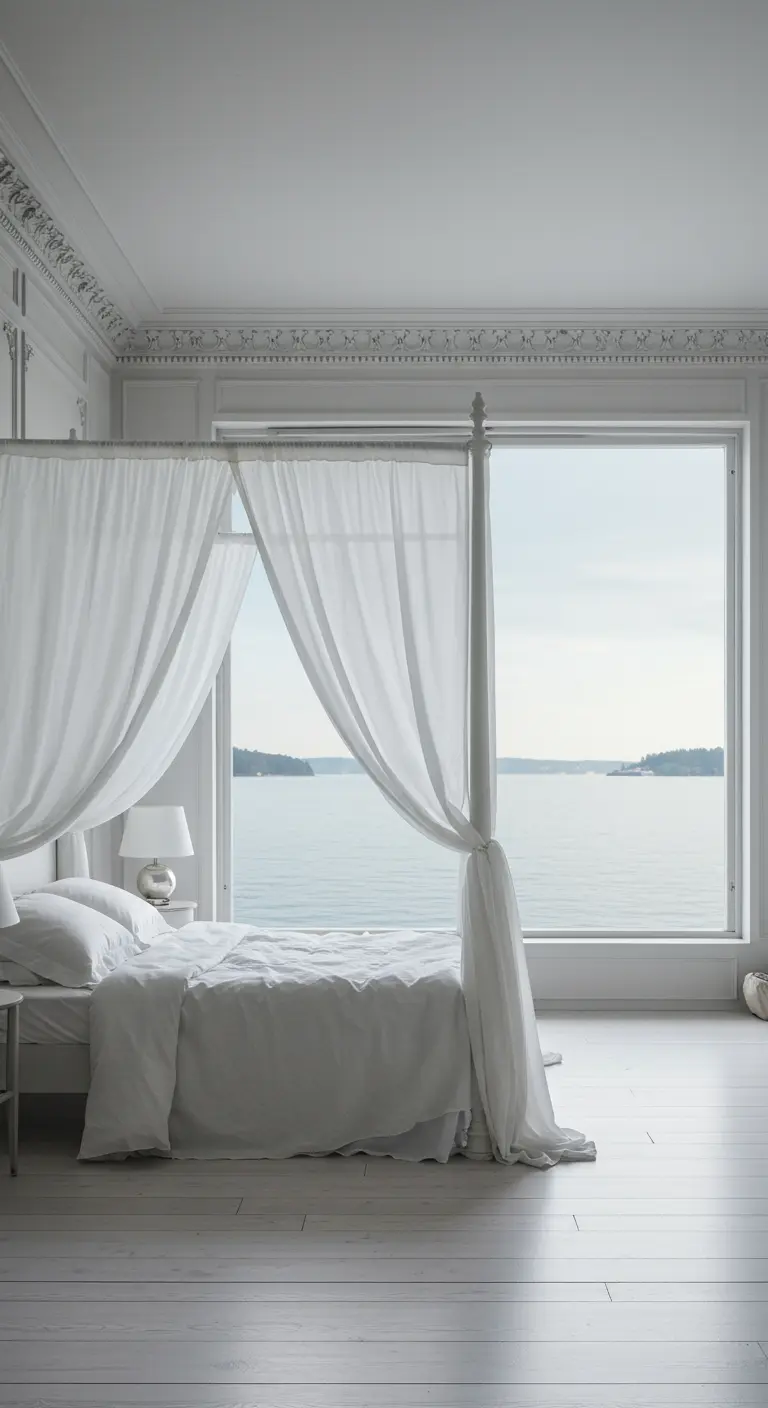
A four-poster bed is inherently romantic, but you can elevate the feeling with lightweight, sheer drapes.
Unlike heavy velvets, gossamer curtains add a sense of enclosure and privacy without blocking light or feeling oppressive.
They move gently in the breeze from an open window, creating a dreamlike atmosphere.
This simple addition transforms the bed into a soft, ethereal, and romantic focal point.
26. Integrate Function with Seamless Style

Even a purely functional space, like a home gym, can and should reflect the style of the rest of your home.
Here, the neoclassical elements of arched windows, herringbone floors, and ornate crown molding are honored.
The equipment is sleek, and the wall-to-wall mirrors not only serve a practical purpose but also amplify the room’s light and space.
This approach maintains an elegant character, feeling more like a clean, minimalist loft than a cluttered gym.
27. Ground a Dark Room with Rich Leather
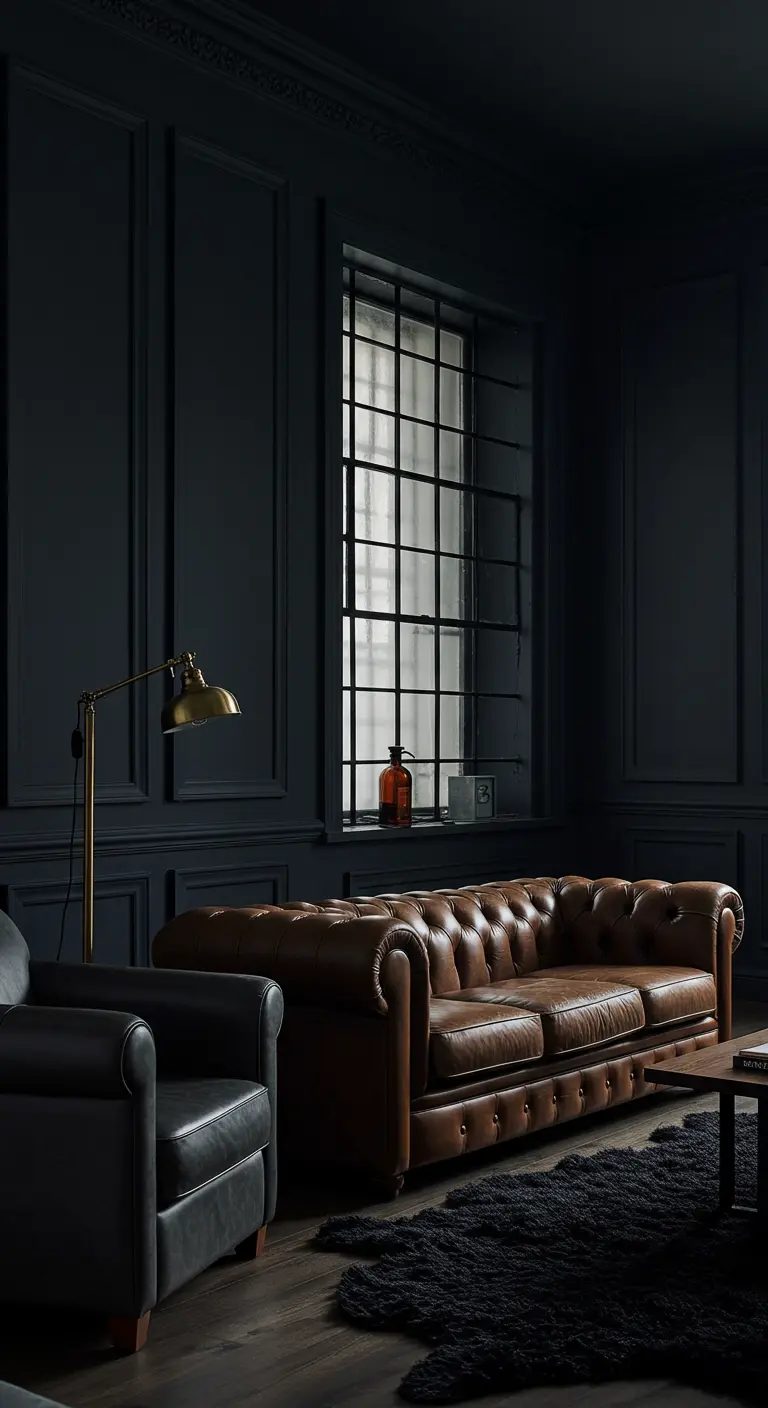
In a dark, moody room, texture and warmth are key to preventing it from feeling one-dimensional.
A classic Chesterfield sofa in a rich, warm cognac leather serves as the perfect anchor.
Its tufted texture catches the light, and the natural warmth of the leather provides a beautiful contrast to the cool, dark tones of the paneled walls.
This balance creates a space that feels sophisticated, historic, and deeply comfortable.
28. Frame Views with Theatrical Drapery
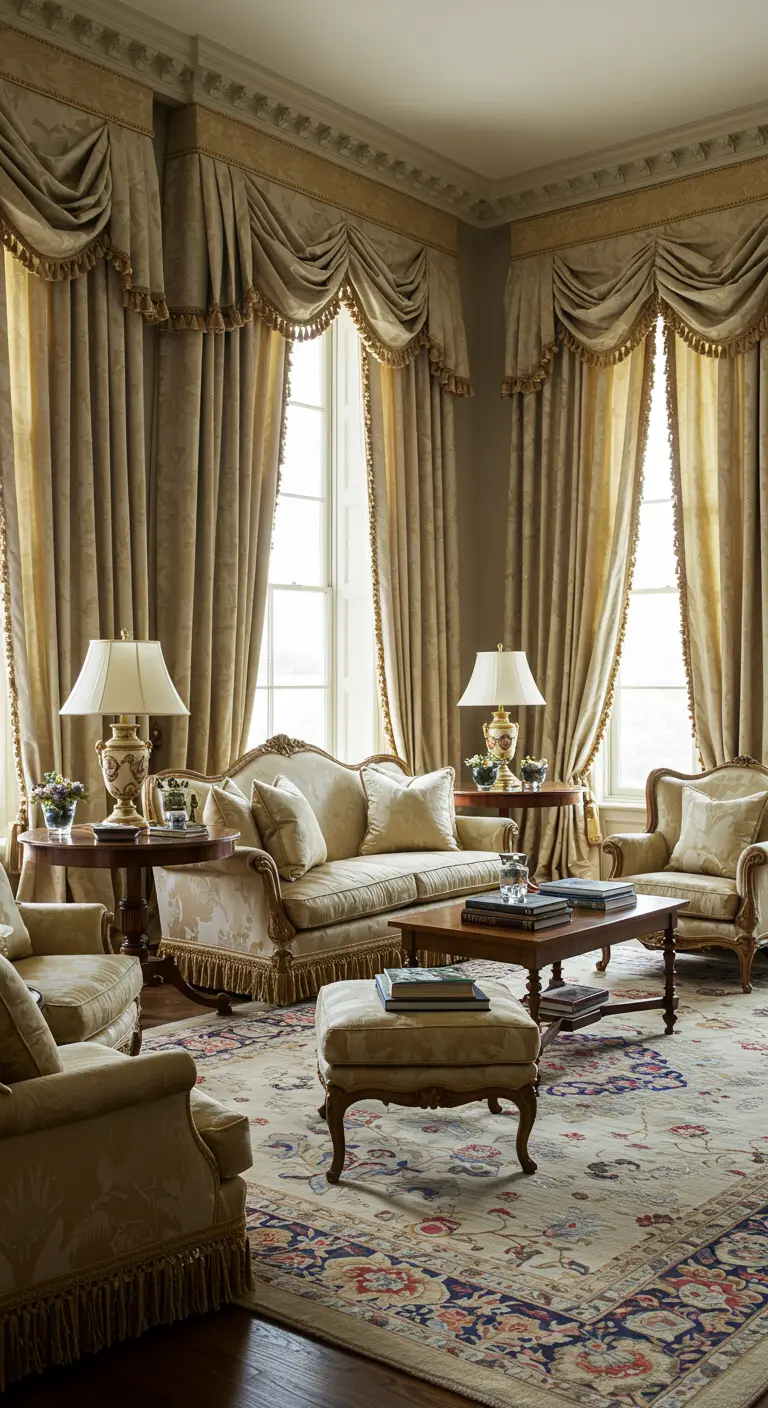
For a truly formal and traditional statement, embrace elaborate window treatments.
Puddled silk or damask curtains with decorative swags, tails, and tassels frame a window like a stage.
This opulent style works best in rooms with very high ceilings and a historical feel, as it adds drama and a sense of history.
It’s a bold choice that speaks to the grandeur of classical design.
29. Maximize Light in an Attic Studio

When designing a room with sloped attic ceilings, your first priority should always be light.
Large skylights are non-negotiable, as they flood the space with overhead light that a traditional window cannot provide.
Next, paint everything a clean, crisp white—walls, ceilings, even the floor—to bounce light around and erase the shadows that can make an attic feel cramped.
Keep furniture simple and functional to maintain an airy, creative atmosphere.
30. Guide the Eye with a Simple Hallway Runner
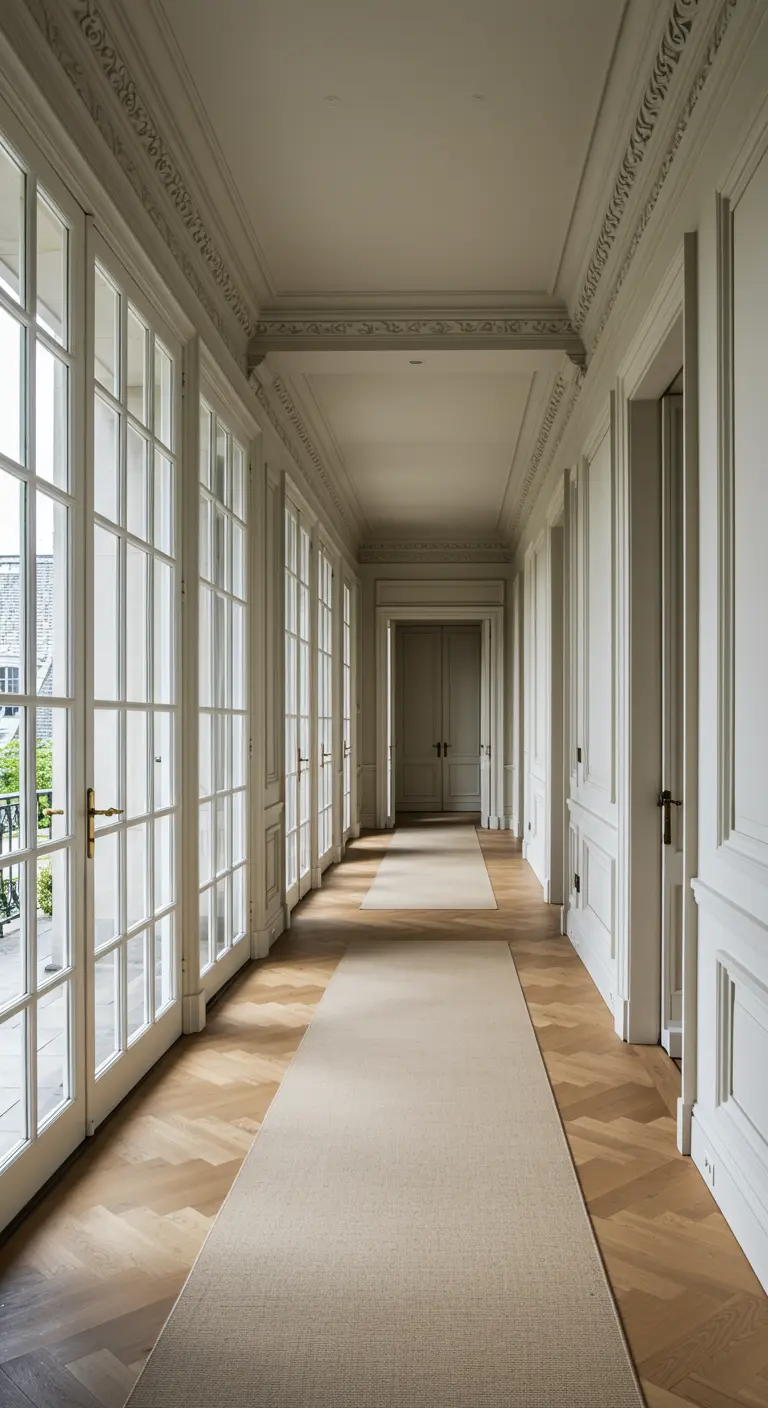
In a long hallway, a runner serves a crucial design purpose beyond just protecting your floors.
It creates a clear visual pathway, guiding the eye and the foot forward and making the journey through the space feel intentional.
In a hallway with significant architectural details like these paneled walls and French doors, a simple, neutral runner is the best choice, as it defines the path without competing for attention.

